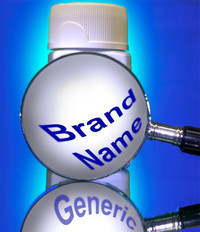What differentiates generics from brand-name medications? That is a question that Andrea Bakker from the Faculty of Medicine of the University of Ottawa tried to answer [1]. In her commentary she explored how differences in licensing affect drug efficacy and how the pharmaceutical landscape in Canada affects patient care.
Generics and brand-name drugs compared
Generics/Research
|
Posted 17/02/2017
 0
Post your comment
0
Post your comment

In 1969, legislation was introduced in Canada to allow the import of generics. This resulted in a large influx of generics into the Canadian market and was followed by additional reform that mandated generics substitution for brand-name drugs unless ‘no substitution’ is specified by the physician. Today, due to automatic substitution laws in Ontario, even if a physician prescribes Lipitor (atorvastatin), the patient will receive generic atorvastatin. In addition to receiving the generic drug version, automatic substitution states that the patient is to receive the least expensive generic brand of atorvastatin with which the pharmacy is currently stocked.
When the brand-name drug is dispensed the increased cost may not be covered by insurance programmes. For example, patients on the Ontario Drug Benefit programme are required to try two interchangeable generics and have a documented adverse drug reaction (ADR) to both before being eligible to receive the brand-name drug at no additional charge.
Drug development
For a brand-name drug, the process of research and development followed by preclinical and clinical trials, usually takes over 10 years and has an estimated cost of CA$2.6 billion per drug. In addition, many candidate drugs never make it to market. It is estimated that for every 5,000 to 10,000 chemicals that enter preclinical testing, only one makes it onto the market. Drug patents grant 20 years of protection for drugs, but only result in on average 10 years of protection once a successful drug hits the market.
A generic drug company, on the other hand, is only required to prove pharmaceutical equivalence and bioequivalence to the brand-name drug. This process only takes two to three years and costs CA$3–10 million.
Differences in drug product
Brand-name drugs contain the original combination of the active ingredient and binders that was tested in clinical trials. Although they often cost at least 50% more than generics, they have the advantage of maintaining consistent packaging and therefore being more recognizable to physicians and patients.
Generics, although containing the same active molecule may be bound by different excipients and are often packaged differently, they are more likely to be covered by insurance and are the default medications used in hospital. However, due to the policy that the patient is to receive the least expensive generic drug, patients may receive generics from different manufacturers with different packaging. Different shapes, colours and packaging for generics may confuse patients and has been linked with a lack of compliance [2].
Differences in drug efficacy
Generics must demonstrate pharmaceutical equivalence and bioequivalence to their respective reference (brand-name) drugs. This means that they must have the same dosage, form and route of administration as the brand-name drug. To demonstrate bioequivalence a single-dose, two-treatment, crossover-designed study has to be carried out in healthy adult volunteers. The results from this study must demonstrate that the area under the curve (AUC), i.e. drug absorption over time, and maximum drug concentration (Cmax) have a 90% confidence interval (CI) that is between 80–125% of the brand-name drug. This could mean that the generic drug delivers less than expected, e.g. only 90% of the expected drug or conversely it could deliver more, e.g. 110%. In drugs with a narrow therapeutic index or critical dose this has been highlighted as a potential problem [3].
The author concluded that ‘generally, generics are less expensive and have comparable efficacy, but have the disadvantage of having packaging that is inconsistent between generic drug brands. They work well, but switching to a generic from a brand name drug and switching between generics is the hardest part’.
Editor’s comment
Readers interested to learn more about generics are invited to visit www.gabi-journal.net to view the following manuscripts published in GaBI Journal:
Statin generics: no differences in efficacy after switching
GaBI Journal is indexed in Embase, Scopus, Thomson Reuters’ ESCI, and more.
Readers interested in contributing a research or perspective paper to GaBI Journal – an independent, peer reviewed academic journal – please send us your submission here.
Related articles
Addressing patient misconceptions about generics
Therapeutic substitution could save Americans US$73 billion
References
1. Bakker A. Is brand name best? Brand name versus generic pharmaceuticals in clinical practice. UOJM. 2017;7(1).
2. GaBI Online - Generics and Biosimilars Initiative. Compliance with generic drug use among Pakistani immigrants [www.gabionline.net]. Mol, Belgium: Pro Pharma Communications International; [cited 2017 Feb 16]. Available from: www.gabionline.net/Generics/Research/Compliance-with-generic-drug-use-among-Pakistani-immigrants
3. GaBI Online - Generics and Biosimilars Initiative. AES position statement on substitution of generic anti-epileptics [www.gabionline.net]. Mol, Belgium: Pro Pharma Communications International; [cited 2017 Feb 16]. Available from: www.gabionline.net/Generics/Research/AES-position-statement-on-substitution-of-generic-anti-epileptics
Permission granted to reproduce for personal and non-commercial use only. All other reproduction, copy or reprinting of all or part of any ‘Content’ found on this website is strictly prohibited without the prior consent of the publisher. Contact the publisher to obtain permission before redistributing.
Copyright – Unless otherwise stated all contents of this website are © 2017 Pro Pharma Communications International. All Rights Reserved.
Most viewed articles
The best selling biotechnology drugs of 2008: the next biosimilars targets
Global biosimilars guideline development – EGA’s perspective
Related content
Japan’s drug shortage crisis: challenges and policy solutions
Saudi FDA drug approvals and GMP inspections: trend analysis
Generic medications in the Lebanese community: understanding and public perception
Community pharmacists’ understanding of generic and biosimilar drugs: Lebanon case study
Generic medications in the Lebanese community: understanding and public perception

Generics/Research Posted 23/01/2024
Community pharmacists’ understanding of generic and biosimilar drugs: Lebanon case study

Generics/Research Posted 08/09/2023
The best selling biotechnology drugs of 2008: the next biosimilars targets








Post your comment